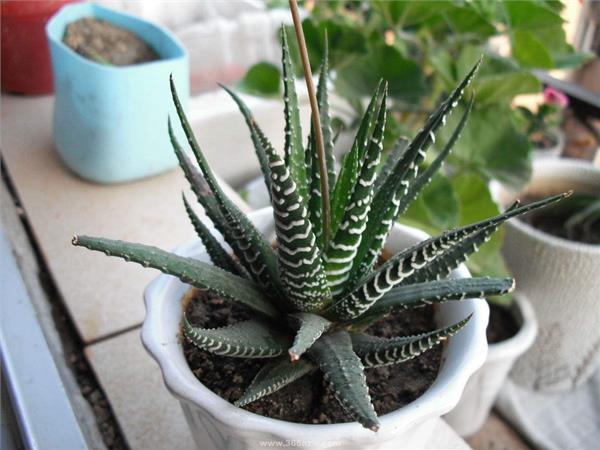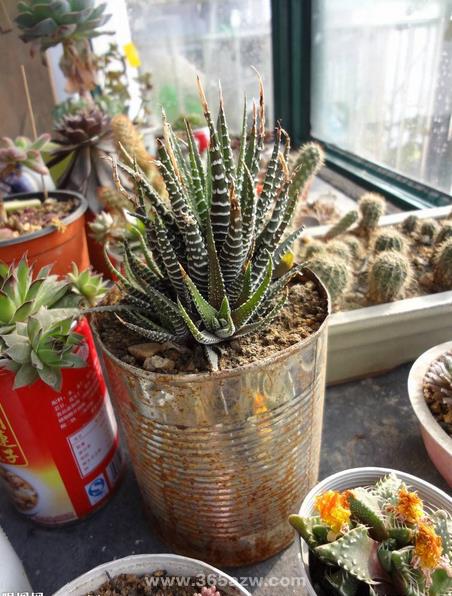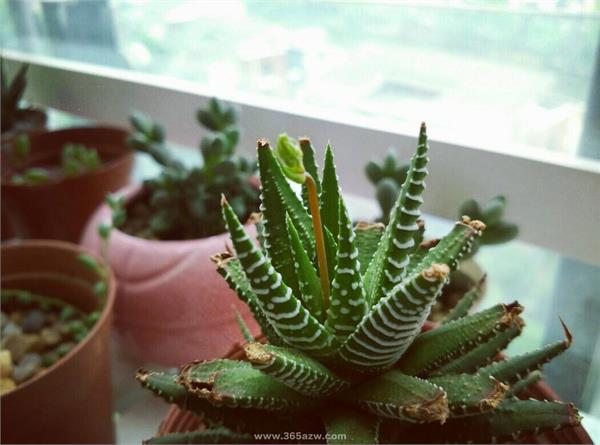Introduction to the main points of ramet propagation and management of twelve stripes
Like warm and semi-shady conditions, cold and cool in winter, and no more than 12 ℃ indoors. Let's take a look at the ramet propagation and management of 12 stripes.

Introduction to the main points of ramet propagation and management of twelve stripes
Perennial succulent herbs. The fleshy leaves are arranged in a rosette with a plant width of 5~7cm. The leaf is long 3~4cm, wide 1.3cm, triangular lanceolate, acuminate, slightly erect, upper inner curved, leaf surface flat, leaf back protruding, keel-shaped, green, with large white verrucous protuberances, arranged with horizontal stripes.
Ramet propagation
Ramet time: preferably after soil thawing in early spring (February or March).
Split method: take the mother plant out of the flowerpot, shake off the excess potted soil, separate the root system as much as possible, cut it into two or more plants with a sharp knife, and each plant should have a considerable root system. and its leaves are properly trimmed to facilitate survival.
Disinfection in a basin: soak the divided plants in 1500 times chlorothalonil solution for five minutes, then take out and dry, and then put on the basin. You can also irrigate the root with chlorothalonil immediately after potting.
Management after ramet: put the ramet into the basin and irrigate the root or irrigate once. Because its root system is greatly damaged and its water absorption capacity is very weak, it takes about 3-4 weeks to recover new roots. Therefore, it is necessary to control watering within 3-4 weeks after ramet to avoid rotting roots, but the transpiration of its leaves is not affected. In order to maintain the water balance of leaves, it is necessary to spray the leaf surface one or three times a day (more spraying at high temperature, less spraying at low temperature or no spraying at low temperature). Don't fertilize it these days. After the split, but also pay attention to the sun is too strong, it is best to put in the shade to maintain.

Key points of management
Humidity: like the drier air environment, overcast and rainy days last too long, easy to be infected by bacteria. For fear of rain, keep the leaves dry at night. The optimum relative humidity of the air is 40-60%.
Temperature: the optimum growth temperature is 15 ℃ ~ 32 ℃. It is afraid of high temperature and muggy heat and enters dormancy when the summer temperature is above 33 ℃. Avoid cold frost, the overwintering temperature needs to be kept above 10 ℃, and when the winter temperature drops below 7 ℃, it will also enter a dormant state. If the ambient temperature is close to 4 ℃, it will die of frostbite.
In the summer:
1. Strengthen the air convection so that the temperature in the body can be released.
2. Put it in the semi-shade, or give it 50% shade
3. Spray it properly, 2 or 3 times a day.
In winter:
1. Move to a brightly lit place for maintenance
2. Outside, it can be wrapped in a film to survive the winter, but the film should be opened every two days when the temperature is high at noon to let it breathe.
Light: leaves will be more beautiful when you keep them in the semi-shade or shade it by 50% in summer. In spring and autumn, because the temperature is not very high, it is necessary to give it direct sunlight to facilitate its photosynthesis to accumulate nutrients. In winter, keep it indoors where there is bright light for maintenance. Usually put in the indoor maintenance, should be placed in the southeast near the doors and windows, in order to receive light, and every month or one and a half months, to move to the outdoor maintenance for two months, otherwise the leaves grow thin, yellow, new branches or petioles slender, elongated internodes, in a state of overgrowth.
Fertilizer and water management: it has strong drought tolerance and can grow under dry environmental conditions, but this does not mean that it does not water or fertilize it; its roots are afraid of water stains, and if there is water in the flowerpot, or if it is watered and fertilized too frequently, it is easy to cause rotten roots. The principle of watering it is "dry and wet, dry and thoroughly dry, not dry, water thoroughly". When watering, avoid wetting the plant during the day:

Spring and autumn: these two seasons are its peak growing season. Fertilizer and water management circulates according to the order of "Huabao"-- clear water-- "Huabao"-- clear water. The interval period is about 2-4 days for outdoor maintenance, and the interval period is shorter during sunny or high temperature days. The interval period is longer or not watered during rainy or low temperature days. Keep it indoors for 3-6 days, with shorter intervals during sunny or high temperatures, longer intervals or no watering during rainy or low temperatures.
Summer: the summer high temperature period it often enters the dormant state, does not require much to the fertilizer and water, even wants to control the fertilizer and water. Fertilizer and water management cycle in accordance with the "Huabao"-clear water-clear water-"Huabao"-clear water-clear water sequence, the interval period is about 3-5 days for outdoor maintenance, and the interval period is shorter during sunny or high temperature periods. The interval period is longer or not watered during rainy or low temperature days; for indoor maintenance for 4-7 days, the interval period is shorter during sunny days or high temperature periods, and longer or unwatered during rainy days or low temperature periods. Watering time should be arranged in the morning or evening when the temperature is low. And spray the plants frequently.
Winter: during the dormant period in winter, the main task is to control fertilizer and water. Fertilizer and water management circulates according to the order of "Hua Bao"-clear water-"Hua Bao"-"Hua Bao"-clear water, with an interval period of about 7-10 days. The interval period is shorter in sunny or high temperature days, longer or unwatered in rainy days or low temperature days. Watering time is arranged as far as possible when the temperature is high at noon on a sunny day.
Tissue culture and rapid propagation
1. Materials: striped twelve-roll stem root buds (plant cells are totipotent, that is, any plant cell has the ability to form the plant body. In other words, any highly differentiated cell has the ability to return to primitive undifferentiated cells and can differentiate into other forms of highly differentiated cells. This "totipotency" is the theoretical basis of plant tissue culture. According to this characteristic of plant cells, any highly differentiated cell of the plant can be cultured at will, and the bud is the highly differentiated part, so choose it.
two。 Culture conditions: MS was used as the basic medium. (composition: KNO3:1650NH4NO3:1900MgSO4.7H2O:370KH2PO4:170CaCl2.2H2O:440MnSO4.4H2O:22.3ZnSO4.7H2O:8.6H3BO3:6.2NaMoO4.2H2O:0.25CuSO4.5H2O:0.025Na2.EDTA:37.3FeSO4.7H2O:27.8 inositol: 100nicotinic acid: 0.5glycine: 2thiamine hydrochloride: 0.1pyridoxine hydrochloride: 0.5KI:0.83CoCl2.6H2O:0.025 sucrose)
Axillary buds with 4-5 young leaves were cut from the stem roots of 12-roll mother plants with potted stripes. Running water washing for 5 minutes 0.2% bromogeramine soaked 30min, running water washing 10min (this method is more water-saving, and the pollution rate is very low). Disinfect 8min with 0.1%HgCl2 on the super clean table, rinse with aseptic water for 10 times, and dry the sterile filter paper. Cut the bud with an anatomical knife and divide the cut young leaves into small pieces of 0.5cm. Inoculated into the culture medium.
3. Bud culture: the 12-roll striped buds expanded and grew rapidly on the medium. After about 20 days, the elongated buds were cut into 3-4 parts and inoculated in another medium. After a week, there is a mass of buds sprouting at the base of each bud (about 5-10).
4. Callus and bud induction: after the young leaves were cultured in the medium for about 2 weeks, there was a layer of colorless and transparent callus on the wound surface. After 20 days of culture, the callus did not proliferate but grew 2-3 buds from above. The buds were cut off and transferred to another medium to form a mass of plantlets.
5. Root induction and transformation: young leaves were cultured in D for one month, and many white globular roots were formed at the wound and increased continuously. When these roots were transferred into the culture medium for about a week, the roots turned green and calli were produced. After two weeks of transfer into another medium, globular embryoids were produced, and some embryoids began to grow young leaves.
6. Subculture and rapid propagation: after repeated separation and microinsertion, the in vitro propagation system of this plant can achieve geometric multiplication, which is called rapid micropropagation or rapid propagation (Rapidpropagation). The rapid propagation of plants is usually carried out after the establishment of the in vitro propagation system, and sometimes the calli can be proliferated rapidly, and liquid suspension culture is usually used.

The shoots or globular embryos obtained above were roughly divided and then proliferated in another medium, which was doubled every two weeks on average. After two months, more than 20 bottles of subculture plants (about 30 plants per bottle) were obtained by using a bud as an exophyte.
7. Rooting of strong seedlings: large seedlings were inoculated in medium E, enhanced light to 10h/d, rooting after a week, and then cultured for about a week before transplanting. When the whole shape of a plant is established by using tissue culture technology, that is, the seedlings with stems, roots and leaves are obtained, they have to undergo certain seedling treatment to gradually change from aseptic environment to aseptic environment, and from artificial culture environment to natural environment. It is customary to use "transitional treatment", that is, gradually change the environment, such as the use of sterilized soil, moisturizing and heat preservation, as well as some strong seedling treatment, such as increasing light and replenishing nutrient solution. After a series of treatments, a tissue-cultured "clone" survived smoothly. )
8. Transplant: open the bottle before coming out of the bottle and refine the seedlings for two days. The seedlings with roots were washed and the culture medium was transferred to the sterile medium of vermiculite + perlite to maintain humidity and the survival rate was higher than 90%.
The interval period is about 7-10 days, which is shorter in sunny or high temperature, longer or unwatered in rainy or low temperature. Watering time is arranged as far as possible when the temperature is high at noon on a sunny day.
Tissue culture and rapid propagation
1. Materials: striped twelve-roll stem root buds (plant cells are totipotent, that is, any plant cell has the ability to form the plant body. In other words, any highly differentiated cell has the ability to return to primitive undifferentiated cells and can differentiate into other forms of highly differentiated cells. This "totipotency" is the theoretical basis of plant tissue culture. According to this characteristic of plant cells, any highly differentiated cell of the plant can be cultured at will, and the bud is the highly differentiated part, so choose it.
two。 Culture conditions: MS was used as the basic medium. (composition: KNO3:1650NH4NO3:1900MgSO4.7H2O:370KH2PO4:170CaCl2.2H2O:440MnSO4.4H2O:22.3ZnSO4.7H2O:8.6H3BO3:6.2NaMoO4.2H2O:0.25CuSO4.5H2O:0.025Na2.EDTA:37.3FeSO4.7H2O:27.8 inositol: 100nicotinic acid: 0.5glycine: 2thiamine hydrochloride: 0.1pyridoxine hydrochloride: 0.5KI:0.83CoCl2.6H2O:0.025 sucrose)
Axillary buds with 4-5 young leaves were cut from the stem roots of 12-roll mother plants with potted stripes. Running water washing for 5 minutes 0.2% bromogeramine soaked 30min, running water washing 10min (this method is more water-saving, and the pollution rate is very low). Disinfect 8min with 0.1%HgCl2 on the super clean table, rinse with aseptic water for 10 times, and dry the sterile filter paper. Cut the bud with an anatomical knife and divide the cut young leaves into small pieces of 0.5cm. Inoculated into the culture medium.
3. Bud culture: the 12-roll striped buds expanded and grew rapidly on the medium. After about 20 days, the elongated buds were cut into 3-4 parts and inoculated in another medium. After a week, there is a mass of buds sprouting at the base of each bud (about 5-10).
4. Callus and bud induction: after the young leaves were cultured in the medium for about 2 weeks, there was a layer of colorless and transparent callus on the wound surface. After 20 days of culture, the callus did not proliferate but grew 2-3 buds from above. The buds were cut off and transferred to another medium to form a mass of plantlets.
5. Root induction and transformation: young leaves were cultured in D for one month, and many white globular roots were formed at the wound and increased continuously. When these roots were transferred into the culture medium for about a week, the roots turned green and calli were produced. After two weeks of transfer into another medium, globular embryoids were produced, and some embryoids began to grow young leaves.
6. Subculture and rapid propagation: after repeated separation and microinsertion, the in vitro propagation system of this plant can achieve geometric multiplication, which is called rapid micropropagation or rapid propagation (Rapidpropagation). The rapid propagation of plants is usually carried out after the establishment of the in vitro propagation system, and sometimes the calli can be proliferated rapidly, and liquid suspension culture is usually used.

The shoots or globular embryos obtained above were roughly divided and then proliferated in another medium, which was doubled every two weeks on average. After two months, more than 20 bottles of subculture plants (about 30 plants per bottle) were obtained by using a bud as an exophyte.
7. Rooting of strong seedlings: large seedlings were inoculated in medium E, enhanced light to 10h/d, rooting after a week, and then cultured for about a week before transplanting. When the whole shape of a plant is established by using tissue culture technology, that is, the seedlings with stems, roots and leaves are obtained, they have to undergo certain seedling treatment to gradually change from aseptic environment to aseptic environment, and from artificial culture environment to natural environment. It is customary to use "transitional treatment", that is, gradually change the environment, such as the use of sterilized soil, moisturizing and heat preservation, as well as some strong seedling treatment, such as increasing light and replenishing nutrient solution. After a series of treatments, a tissue-cultured "clone" survived smoothly. )
8. Transplant: open the bottle before coming out of the bottle and refine the seedlings for two days. The seedlings with roots were washed and the culture medium was transferred to the sterile medium of vermiculite + perlite to maintain humidity and the survival rate was higher than 90%.
Related
- Wuhan Hospital Iron Tree Blooming Result Was Instantly Frightened by the Gardener Master
- Which variety of camellia is the most fragrant and best? Which one do you like best?
- What is the small blue coat, the breeding methods and matters needing attention of the succulent plant
- Dormancy time and maintenance management of succulent plants during dormancy
- Minas succulent how to raise, Minas succulent plant pictures
- What are the varieties of winter succulent plants
- How to raise succulent plants in twelve rolls? let's take a look at some experience of breeding twelve rolls.
- Attention should be paid to water control for succulent plants during dormant period (winter and summer)
- Watering experience of twelve rolls of succulent plants
- Techniques for fertilizing succulent plants. An article will let you know how to fertilize succulent plants.



